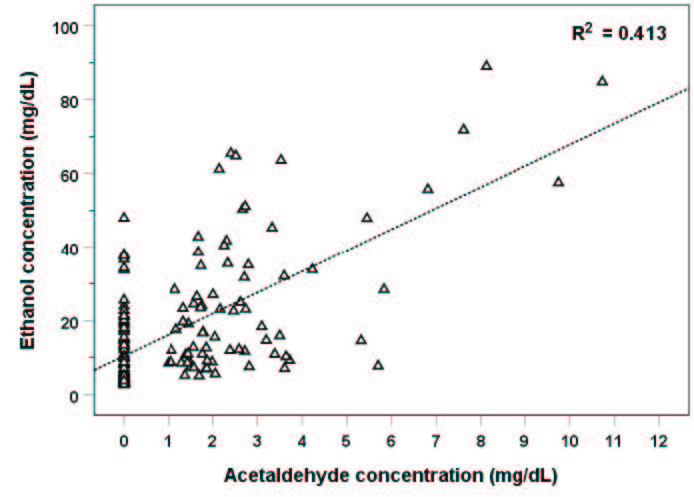Correlation between Postmortem Ethanol Production and Low Molecular Weight Volatiles (LMWVs) in a Thai Population
DOI:
https://doi.org/10.33192/smj.v75i4.260477Keywords:
postmortem ethanol; acetaldehyde; 1-propanol; Thai populationAbstract
Objective: To determine the relationship between postmortem ethanol production and low molecular weight volatiles (LMWVs) in a Thai population.
Materials and Methods: A retrospective study was conducted in 157 Thai cadavers. Various subject data were recorded, including degree of postmortem changes (transition period group vs. decomposition group classified by the total body score [TBS]) and blood profiles of ethanol, acetaldehyde, and 1-propanol concentrations from femoral blood samples that were diagnosed as postmortem production by vitreous humor analysis. Linear regression analysis was performed to determine the correlations between these three analytes and the TBS and between postmortem ethanol and the other two analytes.
Results: This study comprised 44 females and 113 males with a mean age at death of 47.79 years old. Postmortem ethanol, acetaldehyde, and 1-propanol concentrations escalated along with the increased TBS (p<0.001). These three analytes were significantly correlated with the TBS (p<0.001) and the correlations of determination (R2) for postmortem ethanol and 1-propanol were better than for acetaldehyde (R2 = 0.488 and 0.414 vs. 0.269). Acetaldehyde and 1-propanol were positively correlated with postmortem ethanol (p<0.001). The correlations between postmortem ethanol and acetaldehyde, 1-propanol, and the combination of these two analytes produced R2 values of 0.413, 0.480, and 0.544, respectively.
Conclusion: Acetaldehyde and 1-propanol concentrations were significantly correlated with postmortem ethanol concentrations in Thai cadavers, and the combination of these two markers produced a better correlation with the postmortem ethanol concentration.
References
Kugelberg FC, Jones AW. Interpreting results of ethanol analysis in postmortem specimens: a review of the literature. Forensic Sci Int. 2007;165(1):10-29.
Ziavrou K, Boumba VA, Vougiouklakis TG. Insights into the origin of postmortem ethanol. Int J Toxicol. 2005;24(2):69-77.
Gilliland MG, Bost RO. Alcohol in decomposed bodies: postmortem synthesis and distribution. J Forensic Sci. 1993;38(6):1266-74.
Caplan YH, Levine B. Vitreous humor in the evaluation of postmortem blood ethanol concentrations. J Anal Toxicol. 1990;14(5):305-7.
Canfield DV, Kupiec T, Huffine E. Postmortem alcohol production in fatal aircraft accidents. J Forensic Sci. 1993;38(4):914-7.
Mayes R, Levine B, Smith ML, Wagner GN, Froede R. Toxicologic findings in the USS Iowa disaster. J Forensic Sci. 1992;37(5):1352-7.
Oshaug K, Kronstrand R, Kugelberg FC, Kristoffersen L, Mørland J, Høiseth G. Frequency of postmortem ethanol formation in blood, urine and vitreous humor - Improving diagnostic accuracy with the use of ethylsulphate and putrefactive alcohols. Forensic Sci Int. 2022;331:111152.
Ceciliason AS, Andersson MG, Lundin E, Sandler H. Microbial neoformation of volatiles: implications for the estimation of post-mortem interval in decomposed human remains in an indoor setting. Int J Legal Med. 2021;135(1):223-233.
Chen X, Dong X, Zhu R, Xue Q, Zhang D, Liu X, et al. Abnormally High Blood Acetaldehyde Concentrations Suggest Potential Postmortem Ethanol Generation. J Anal Toxicol. 2021;45(7):748-755.
Boumba VA, Exadactylou P, Velivasi G, Ziavrou KS, Fragkouli K, Kovatsi L. The frequency of ethanol, higher alcohols and other low molecular weight volatiles in postmortem blood samples from unnatural deaths. Forensic Sci Int. 2022;341:111503.
Boumba VA, Ziavrou KS, Vougiouklakis T. Biochemical pathways generating post-mortem volatile compounds co-detected during forensic ethanol analyses. Forensic Sci Int. 2008;174(2-3):133-51.
Moffatt C, Simmons T, Lynch-Aird J. An Improved Equation for TBS and ADD: Establishing a Reliable Postmortem Interval Framework for Casework and Experimental Studies. J Forensic Sci. 2016;61 Suppl 1:S201-7.
Megyesi MS, Nawrocki SP, Haskell NH. Using accumulated degree-days to estimate the postmortem interval from decomposed human remains. J Forensic Sci. 2005;50(3):618-26.
Gelderman HT, Boer L, Naujocks T, IJzermans ACM, Duijst WLJM. The development of a post-mortem interval estimation for human remains found on land in the Netherlands. Int J Legal Med. 2018;132(3):863-873.
Wongchanapai W, Dokpuang D, Sasithonrojanachai S, Tamtakerngkit S. Stability of postmortem blood ethanol under experimental conditions. Siriraj Med J 2008;60:62-65.
Scientific Working Group for Forensic Toxicology. Scientific Working Group for Forensic Toxicology (SWGTOX) standard practices for method validation in forensic toxicology. J Anal Toxicol. 2013;37(7):452-74.
Boumba VA, Economou V, Kourkoumelis N, Gousia P, Papadopoulou C, Vougiouklakis T. Microbial ethanol production: experimental study and multivariate evaluation. Forensic Sci Int. 2012;215(1-3):189-98.

Published
How to Cite
License
Copyright (c) 2023 Siriraj Medical Journal

This work is licensed under a Creative Commons Attribution-NonCommercial-NoDerivatives 4.0 International License.
Authors who publish with this journal agree to the following conditions:
Copyright Transfer
In submitting a manuscript, the authors acknowledge that the work will become the copyrighted property of Siriraj Medical Journal upon publication.
License
Articles are licensed under a Creative Commons Attribution-NonCommercial-NoDerivatives 4.0 International License (CC BY-NC-ND 4.0). This license allows for the sharing of the work for non-commercial purposes with proper attribution to the authors and the journal. However, it does not permit modifications or the creation of derivative works.
Sharing and Access
Authors are encouraged to share their article on their personal or institutional websites and through other non-commercial platforms. Doing so can increase readership and citations.














